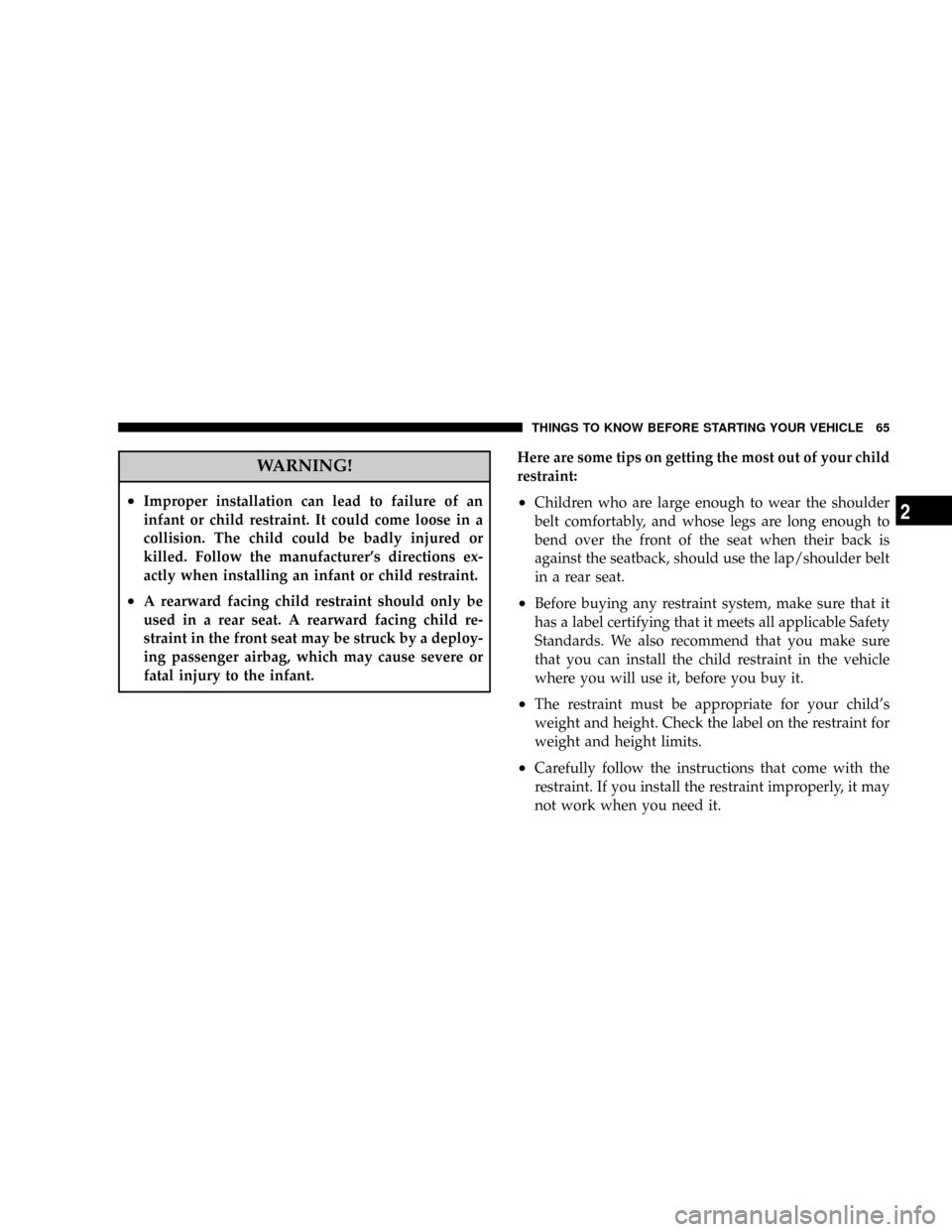Page 65 of 454

WARNING!
²Improper installation can lead to failure of an
infant or child restraint. It could come loose in a
collision. The child could be badly injured or
killed. Follow the manufacturer's directions ex-
actly when installing an infant or child restraint.
²A rearward facing child restraint should only be
used in a rear seat. A rearward facing child re-
straint in the front seat may be struck by a deploy-
ing passenger airbag, which may cause severe or
fatal injury to the infant.Here are some tips on getting the most out of your child
restraint:
²Children who are large enough to wear the shoulder
belt comfortably, and whose legs are long enough to
bend over the front of the seat when their back is
against the seatback, should use the lap/shoulder belt
in a rear seat.
²Before buying any restraint system, make sure that it
has a label certifying that it meets all applicable Safety
Standards. We also recommend that you make sure
that you can install the child restraint in the vehicle
where you will use it, before you buy it.
²The restraint must be appropriate for your child's
weight and height. Check the label on the restraint for
weight and height limits.
²Carefully follow the instructions that come with the
restraint. If you install the restraint improperly, it may
not work when you need it.
THINGS TO KNOW BEFORE STARTING YOUR VEHICLE 65
2
Page 197 of 454

RADIO GENERAL INFORMATION
Radio Broadcast Signals
Your new radio will provide excellent reception under
most operating conditions. Like any system, however, car
radios have performance limitations, due to mobile op-
eration and natural phenomena, which might lead you to
believe your sound system is malfunctioning. To help
you understand and save you concern about these ªap-
parentº malfunctions, you must understand a point or
two about the transmission and reception of radio sig-
nals.
Two Types of Signals
There are two basic types of radio signals... AM or
Amplitude Modulation, in which the transmitted sound
causes the amplitude, or height, of the radio waves to
vary... and FM or Frequency Modulation, in which the
frequency of the wave is varied to carry the sound.
Electrical Disturbances
Radio waves may pick up electrical disturbances during
transmission. They mainly affect the wave amplitude,
and thus remain a part of the AM reception. They
interfere very little with the frequency variations that
carry the FM signal.
AM Reception
AM sound is based on wave amplitude, so AM reception
can be disrupted by such things as lightning, power lines
and neon signs.
FM Reception
Because FM transmission is based on frequency varia-
tions, interference that consists of amplitude variations
can be filtered out, leaving the reception relatively clear,
which is the major feature of FM radio.
UNDERSTANDING YOUR INSTRUMENT PANEL 197
4
Page 281 of 454
Tire Sizing Chart
EXAMPLE:
Size Designation:
P= Passenger car tire size based on U.S. design standards
(....blank....(= Passenger car tire based on European design standards
LT= Light Truck tire based on U.S. design standards
T= Temporary Spare tire
31= Overall Diameter in Inches (in)
215= Section Width in Millimeters (mm)
65= Aspect Ratio in Percent (%)
ÐRatio of section height to section width of tire
10.5= Section Width in Inches (in)
R= Construction Code
Ð9R9means Radial Construction
Ð9D9means Diagonal or Bias Construction
15= Rim Diameter in Inches (in)
STARTING AND OPERATING 281
5
Page 323 of 454

weighed in combination. (Note that GCWR ratings in-
clude a 150 lbs (68 kg) allowance for the presence of a
driver).
Gross Axle Weight Rating (GAWR)
The Gross Axle Weight Rating (GAWR) is the maximum
capacity of the front and rear axles. Distribute the load
over the front and rear axles evenly. Make sure that you
do not exceed either front or rear GAWR.
WARNING!
It is important that you do not exceed the maximum
front or rear GAWR. A dangerous driving condition
can result if either rating is exceeded. You could lose
control of the vehicle and have an accident.
Tongue Weight (TW)
Tongue Weight (TW) is the downward force exerted on
the hitch ball by the trailer. In most cases it should not be
less than or more than 10% of the trailer load. You must
consider this as part of the load on your vehicle.
Frontal Area
Frontal Area is the maximum height and maximum
width of the front of a trailer and its cargo.
Weight-Carrying Hitch
A weight-carrying hitch supports the trailer tongue
weight, just as if it were luggage located at a hitch ball or
some other connecting point of the truck. These kinds of
hitches are the most popular on the market today and
they're commonly used to tow small- and medium-sized
trailers.
STARTING AND OPERATING 323
5
Page 448 of 454

Seat Belt Maintenance.................... 392
Seat Belt Reminder.....................45,46
Seat Belts..........................39,40,75
And Pregnant Women................... 47
Child Restraint...................62,63,64,69
Extender............................. 48
Front Seat..........................40,41
Inspection............................ 75
Operating Instructions................... 41
Pretensioners.......................... 45
Rear Seat............................. 40
Reminder............................ 177
Untwisting Procedure.................... 44
Seats................................. 130
Adjustment.......................... 130
Cleaning............................ 390
Easy Entry........................... 133
Head Restraints.....................54,135
Heated............................. 135Height Adjustment..................... 134
Lumbar Support....................... 132
Memory............................. 133
Power.............................. 134
Reclining............................ 131
Seatback Release....................... 133
Tilting.............................. 134
Selection of Coolant (Antifreeze)..........376,410
Selection of Oil......................... 363
Sentry Key (Immobilizer)................... 15
Sentry Key Programming................... 17
Service Assistance....................... 423
Service Contract......................... 425
Service Manuals........................ 428
Setting the Clock................196,200,215,218
Settings, Personal........................ 194
Shifting
Automatic Transaxle.................... 255
Shoulder Belts........................... 40
448 INDEX